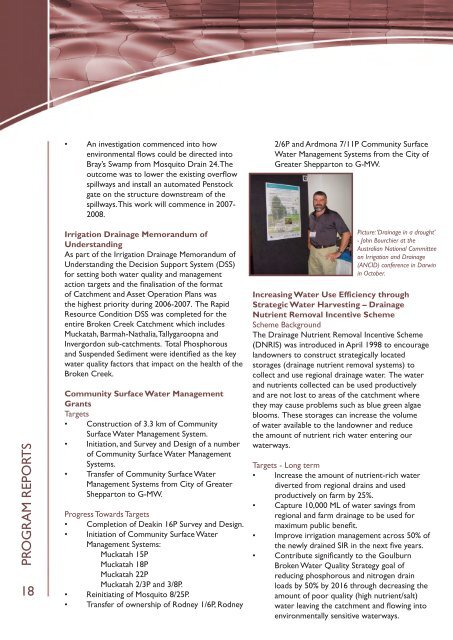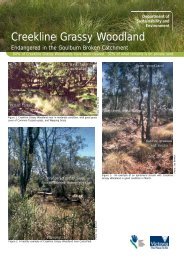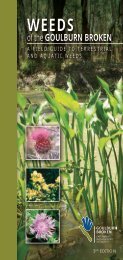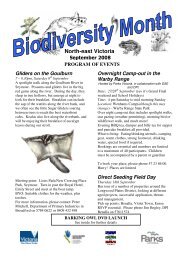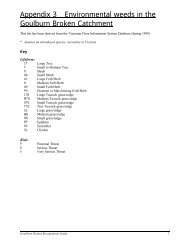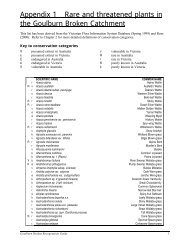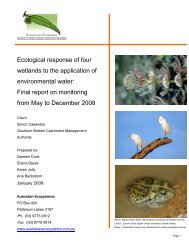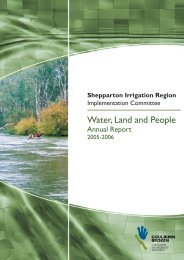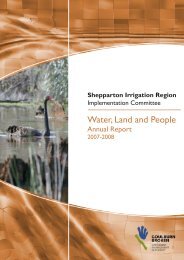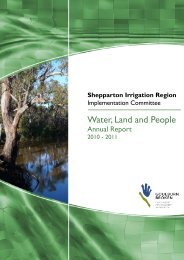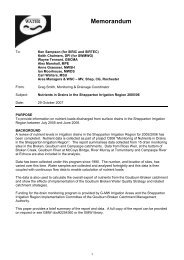Water, Land and People - Goulburn Broken Catchment ...
Water, Land and People - Goulburn Broken Catchment ...
Water, Land and People - Goulburn Broken Catchment ...
Create successful ePaper yourself
Turn your PDF publications into a flip-book with our unique Google optimized e-Paper software.
PROGRAM REPORTS<br />
18<br />
• An investigation commenced into how<br />
environmental flows could be directed into<br />
Bray’s Swamp from Mosquito Drain 24. The<br />
outcome was to lower the existing overflow<br />
spillways <strong>and</strong> install an automated Penstock<br />
gate on the structure downstream of the<br />
spillways. This work will commence in 2007-<br />
2008.<br />
Irrigation Drainage Memor<strong>and</strong>um of<br />
Underst<strong>and</strong>ing<br />
As part of the Irrigation Drainage Memor<strong>and</strong>um of<br />
Underst<strong>and</strong>ing the Decision Support System (DSS)<br />
for setting both water quality <strong>and</strong> management<br />
action targets <strong>and</strong> the finalisation of the format<br />
of <strong>Catchment</strong> <strong>and</strong> Asset Operation Plans was<br />
the highest priority during 2006-2007. The Rapid<br />
Resource Condition DSS was completed for the<br />
entire <strong>Broken</strong> Creek <strong>Catchment</strong> which includes<br />
Muckatah, Barmah-Nathalia, Tallygaroopna <strong>and</strong><br />
Invergordon sub-catchments. Total Phosphorous<br />
<strong>and</strong> Suspended Sediment were identified as the key<br />
water quality factors that impact on the health of the<br />
<strong>Broken</strong> Creek.<br />
Community Surface <strong>Water</strong> Management<br />
Grants<br />
Targets<br />
• Construction of 3.3 km of Community<br />
Surface <strong>Water</strong> Management System.<br />
• Initiation, <strong>and</strong> Survey <strong>and</strong> Design of a number<br />
of Community Surface <strong>Water</strong> Management<br />
Systems.<br />
• Transfer of Community Surface <strong>Water</strong><br />
Management Systems from City of Greater<br />
Shepparton to G-MW.<br />
Progress Towards Targets<br />
• Completion of Deakin 16P Survey <strong>and</strong> Design.<br />
• Initiation of Community Surface <strong>Water</strong><br />
Management Systems:<br />
Muckatah 15P<br />
Muckatah 18P<br />
Muckatah 22P<br />
Muckatah 2/3P <strong>and</strong> 3/8P.<br />
• Reinitiating of Mosquito 8/25P.<br />
• Transfer of ownership of Rodney 1/6P, Rodney<br />
2/6P <strong>and</strong> Ardmona 7/11P Community Surface<br />
<strong>Water</strong> Management Systems from the City of<br />
Greater Shepparton to G-MW.<br />
Picture: ‘Drainage in a drought’<br />
- John Bourchier at the<br />
Australian National Committee<br />
on Irrigation <strong>and</strong> Drainage<br />
(ANCID) conference in Darwin<br />
in October.<br />
Increasing <strong>Water</strong> Use Efficiency through<br />
Strategic <strong>Water</strong> Harvesting – Drainage<br />
Nutrient Removal Incentive Scheme<br />
Scheme Background<br />
The Drainage Nutrient Removal Incentive Scheme<br />
(DNRIS) was introduced in April 1998 to encourage<br />
l<strong>and</strong>owners to construct strategically located<br />
storages (drainage nutrient removal systems) to<br />
collect <strong>and</strong> use regional drainage water. The water<br />
<strong>and</strong> nutrients collected can be used productively<br />
<strong>and</strong> are not lost to areas of the catchment where<br />
they may cause problems such as blue green algae<br />
blooms. These storages can increase the volume<br />
of water available to the l<strong>and</strong>owner <strong>and</strong> reduce<br />
the amount of nutrient rich water entering our<br />
waterways.<br />
Targets - Long term<br />
• Increase the amount of nutrient-rich water<br />
diverted from regional drains <strong>and</strong> used<br />
productively on farm by 25%.<br />
• Capture 10,000 ML of water savings from<br />
regional <strong>and</strong> farm drainage to be used for<br />
maximum public benefit.<br />
• Improve irrigation management across 50% of<br />
the newly drained SIR in the next five years.<br />
• Contribute significantly to the <strong>Goulburn</strong><br />
<strong>Broken</strong> <strong>Water</strong> Quality Strategy goal of<br />
reducing phosphorous <strong>and</strong> nitrogen drain<br />
loads by 50% by 2016 through decreasing the<br />
amount of poor quality (high nutrient/salt)<br />
water leaving the catchment <strong>and</strong> flowing into<br />
environmentally sensitive waterways.


